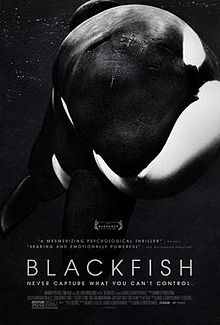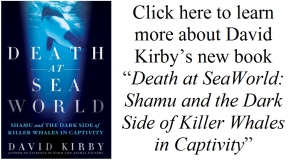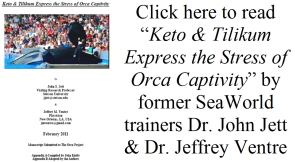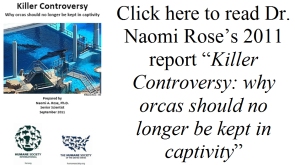Exclusive Interview: Former SeaWorld trainer John Jett PhD talks Tilikum with T.O.P.
On October 17, 2010, 60 Minutes Australia ran a piece called Natural Born Killers showcasing Tilikum, the Killer Whale who killed his longtime trainer Dawn Brancheau in February of 2010. Today, Dr. John Jett, who was featured in the 60 Minutes piece, joined The Orca Project for an exclusive telephone interview to discuss Tilikum, his years as an Orca Trainer at SeaWorld Orlando and his recent visit with orcas in their natural habitat.
PREFACE: John Jett, PhD is a marine mammal scientist and visiting research professor at Stetson University, in Deland, Florida. Dr Jett was a trainer at Sea World of Florida for several years in the mid 1990’s. He worked extensively with Tilikum; was the big orca’s team leader, and also worked with Dawn Brancheau, who was killed by Tilikum on 24 February 2010. This past month he was interviewed for a featured segment that aired on 60 Minutes of Australia which can be seen here:
In July 2010, John’s comments appeared in Tim Zimmermann’s benchmark article, “Killer in the Pool”, and in March of this year Dr Jett’s Op-ED piece to Anderson Cooper was widely read, and is still referenced frequently today.
EXCLUSIVE INTERVIEW: Former SeaWorld killer-whale trainer John Jett, PhD (JJ) talks about Tilikum and orcas with The Orca Project (TOP):
TOP: Dr. Jett, thanks for taking a break from classes to speak with TOP regarding orcas and Tilikum. Many of our readers have never seen an orca in the field. What’s it like seeing killer whales in the wild?
JJ: You see these magnificent animals in this great setting, doing their own thing in their own time… and it’s spectacular.
TOP: It sounds like a powerful experience. Do most orca trainers have opportunities to see wild populations of orcas? And how many of the former trainers you worked with had seen a wild killer whale prior to working for Sea World?
JJ: When I was at SW, I know of only one or two that had ever seen a wild killer whale. And they were in supervisory roles and had been invited to see killer whales as part of creating a new show. Other than that I knew of no one. Certainly no one at the staff level.
TOP: John, you’re one of a few people in the world that has both captive and field experiences with killer whales. How can you harness this relatively unique perspective to help educate the public regarding the strife of both captive and wild populations?
JJ: Well, first of all, there are obvious problems with both groups. What I hope to do is parlay my experience in the field in such a way as to convince people that killer whales simply don’t belong in a captive environment.

Dr. Jett joins the 60 Minutes crew in Haro Strait off the coast of San Juan Island, Washington State
TOP: We know that the Southern Resident population has been described as “endangered”. What do you feel are the top issues impacting wild orcas, in general?
JJ: Certainly declines in fish stocks, especially Chinook salmon, are having a large impact on their abilities to procure sufficient calories. PCB contaminants and other man-made toxins are also high on the list of stressors, especially when compounded by nutritional deficiencies. There is also some evidence that commercial and recreational whale watching are impacting habitat utilization. And of course collections by the marine park industry, albeit years ago, are still having an impact based on the negative effects on reproductive rates.
TOP: Sea World and other marine parks have done an effective job glamorizing the life of a killer whale trainer. There are literally thousands of young people that would do just about anything to get the job of a trainer. Do you have any specific message to those young folks out there that want to swim with Shamu?
JJ: Low pay and hazardous working conditions should be sufficient to dissuade anyone but the most ignorant among us. That said, few trainers possess specialized skills or educational training such as might accompany an undergraduate or graduate degree in the sciences. Reality is that a job as a killer whale trainer requires mostly the same skills as other theme park workers–the ability to look good and be well-spoken in front of a crowd.
TOP: In the recent 60 Minutes (Australia) story, Dr. Naomi Rose mentions the social strife between Kalina and Kayla on the day of Dawn’s death. Do you believe that social strife could have impacted Tilikum’s psychology and affected his state of mind?
JJ: Most certainly. Killer whales are extremely social animals, and most of the communication is done under water, out of sight of humans. And in a pool system in which every pool is connected, it’s naive to think that the social strife that occurred prior to Dawn’s death did not somehow contribute to the tragedy.
TOP: It’s been discussed at various blogs that Dawn’s session with Tilikum was long, and suboptimal. Tilikum didn’t look sharp, especially after his perimeter pec wave. Any speculation as to why the session seemed to linger? Could the presence of VIP’s at the Dine With Shamu experience affected the duration of the presentation?
JJ: There’s always pressure anytime there are VIP’s present. There is always pressure to put on a show. And since the Shamu show was cancelled preceding the incident, it makes sense that there would be some compensation in the duration of the Dine with Shamu presentation. And it’s true that the session was suboptimal at best. And it is true that the session dragged on and on and on with very little reinforcement. It’s easy to see how Tilikum may have become frustrated.
TOP: In your OP-ED piece to Anderson Cooper you state, “The recent death of a SeaWorld trainer should cause us as a society to ponder the wisdom of keeping large carnivores such as killer whales in captive environments.” Do you think that this tragedy could, perhaps, have a silver lining? And if so, how?
JJ: I do think it could have a silver lining. The silver lining is that some of the truth, including ugly truths regarding this industry are now coming to light.
TOP: John, in researching some of your public statements regarding orcas in captive environments, we used the “Orca Tracker”. Are you familiar with it?
JJ: Yes. Orca Tracker to me represents a one stop clearinghouse for all things orca.
TOP: According to eyewitness reports, Tilikum is more isolated than ever. During the 60-Minutes (Australia) program, it was stated that he gets no physical contact, and is occasionally hosed down from two meters away. How do you think this relative isolation is impacting the big orca’s state of mind?
JJ: First of all, his isolation is completely and utterly tragic. Especially considering how social these animals are in the wild. And so, while we can’t get into Tilikum’s head, we can speculate that it’s not been good for him.
TOP: Finally, John, SeaWorld spokespeople continue to say that Tilikum pulled Dawn into the water by her hair. According to statements by Susan Connell, and also in the Orange County Sheriff’s Investigation, neither Jan Topoleski, nor Lynne Schaber actually saw the take down. What evidence, then, is SW basing the pony-tail theory on?
JJ: In my mind, they are basing it on nothing more than what they want to put out; nothing more than the story line that they want to perpetuate. The evidence is quite clear that it was initially an arm grab and had nothing to do with Dawn’s ponytail.
TOP: Thank you very much John. That concludes our interview.
—————————————————————————–
You can read more from Dr. Jett in a recent Orlando Sentinel story: “Former whale trainers criticize SeaWorld safety proposal” and watch him on ABC News Nightline: “Sea World Cited in Trainer’s Death”
For more information and exclusive content, visit John Jett’s page HERE at Voice of the Orcas, a new website created by four former SeaWorld trainers, sharing a common philosophy to provide a voice to those without.
And don’t forget to check out these other exclusive former trainer interviews on The Orca Project:
Exclusive Interview #2: Former SeaWorld trainer Carol Ray talks orca safety & separation with T.O.P.
For a wealth of orca information, please visit Orca Tracker, a geospatial interactive map connecting orca events and scholars from around the world.
Trackbacks
- SeaWorld’s Proposed Multi-Million-Dollar Safety Gimmicks Don’t Measure Up | The Orca Project
- Author of “Death at SeaWorld” on NPR Radio Orlando « The Orca Project
- Death at SeaWorld: Shamu and the Dark Side of Killer Whales in Captivity « The Orca Project
- SeaWorld vs. OSHA- Killer Whale Showdown in Florida « The Orca Project
- SeaWorld Trainer Death Theory Debunked as a Ponytail Tale « The Orca Project
- SeaWorld’s Proposed Multi-Million-Dollar Safety Gimmicks Don’t Measure Up « The Orca Project
- Exclusive Interview #3: Former SeaWorld trainer Samantha Berg and the Perils of Orca Captivity (part 1) « The Orca Project
- Could "Spare Air" Save Marine Park Trainers During Orca Attacks? « The Orca Project
- Exclusive Interview #2: Former SeaWorld trainer Carol Ray talks orca safety and separation with T.O.P. « The Orca Project
- Exclusive Interview: |












I got this site from my friend who shared with me on the topic of
this site and now this time I am browsing this web page and reading
very informative posts at this place.
I watched Black Fish and Mr. Jett you seem to know what is going on best. I really hope you become the main voice in regards to setting these whales free!!
Left field here..I have been watching the show on CNN…my heart goes out to the trainers, may the trainers who have lost their lives RIP, and yes, I believe Sea World should change their M.O.
That is an enlightening article. The interview is in depth, nuanced, thoughtful, and describes the plight of both captive and wild orca populations. John gave a great interview. Tilikum’s life is particularly tragic, and saddening. I hope that TOP will continue to research and publish interesting stories of this type and quality so the people can see behind the marine park industry’s PR cloak of secrecy and falsehoods. The 60 Minutes video is outstanding. Thank you TOP.
I kind of feel sorry for Ms Clarke. It must be hard to tow the company line, yet know the truth about what happened to your friend. But then she angers me with this
“No, you know, the behaviour that he was showing us was not hunting behaviour. It was not aggressive behaviour. It was not, ah, um, killing behaviour.”
SO she knows that for sure, yet later states she doesn’t know what Tilli was thinking or how to describe how he was behaving, but she knows it wasn’t hunting,agreesive or killing. Then she pulls the whole “we are so ignorant we don’t speak a whales language” crap with the interviewer. Really? I mean REALLY!!! What a hypocrite ! They must think collectively we are morons.
I’m curios about the “not giving up” behavior that everyone who tried to save Dawn mentioned. In particular this interaction with Dr Jett.
MICHAEL USHER: He was determined to kill her?
DR JOHN JETT: It’s quite evident that Tilikum was determined to keep her.
He was determined to keep her or as the trainers said “not give her up” . Is that common in the wild or a natural instinct? I mean we know they like to play or toy with a kill…is that why he wouldn’t give her up? She was his kill/toy ? Would he have still been angry/distressed at the point he was put in the med pool? Is that why they had to force him to give her up?
The other thing after watching the footage of the 2006 attack on Ken Peters by Kasatka – by the way how did he not panic? the footage is chilling – I read the witness and victim reports and I find it interesting that Ken, just prior to the attack, heard her calf calling to her under water possibly in distress. Then when you look at the agressive behavior of the 2 females that cancelled the Believe show prior to Tilli attacking Dawn. It HAS to be the reason for the sudden aggressive behavior – disruption with in the “society” Right? I wonder if anything similar happened with Alexis and Keltie?
Maybe the answer is until SW can be forced somehow to stop the shows/performances permanently, that they are made by OSHA or legislation to put Trainer safety as a priority ahead of making dollars and MAKE THEM pull all trainers from the water and the shallows around the pools and keep them behind guard rails when any whale, in any pool acts up. Stuff the VIPs protect the whales and trainers until the whales calm down.
The other thing I don’t get – they want to use the implausible ponytail excuse. If they want to try and blame Dawn by saying she was careless or didn’t follow protocol by being so close to Tilli why not just go with the “she shouldn’t have been that close with her hand in his mouth” explanation…I mean what the heck is the difference? old Thad can still say Dawn was to blame because it was against procedure its the same damn defense. GOD her poor family..what a way to treat a loyal employee and star of your business in the aftermath of her death.